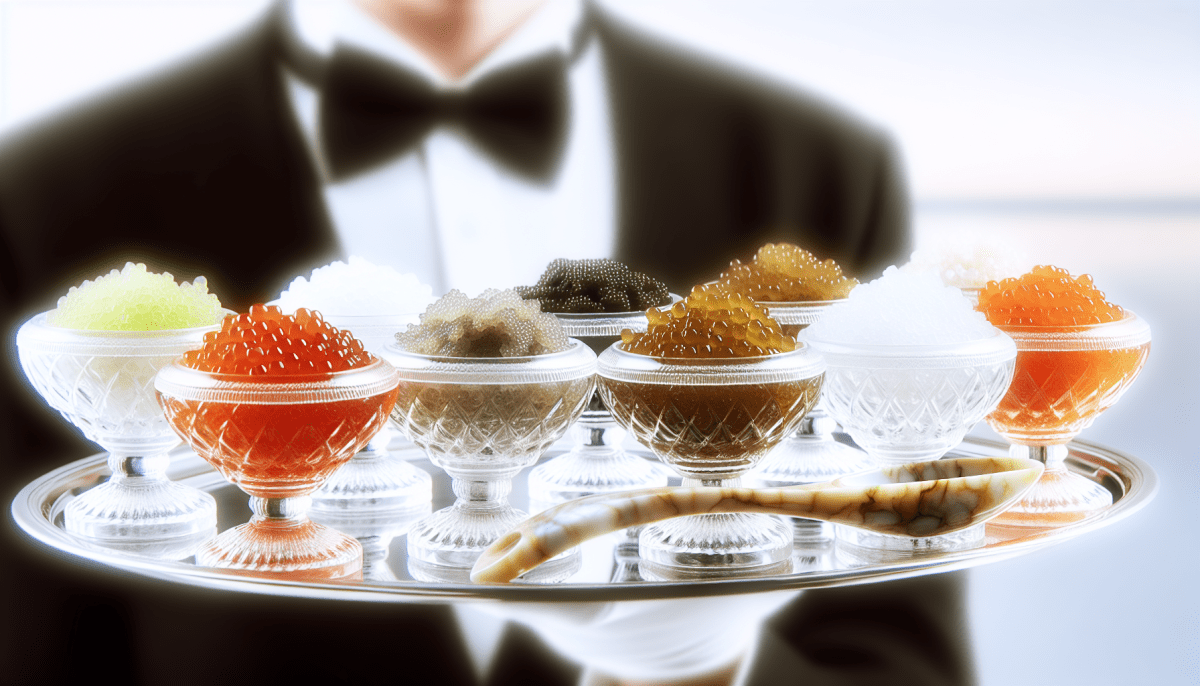Beluga Caviar is the largest and most sought-after caviar, known for its soft, buttery texture and delicate flavor. Sourced from the Beluga sturgeon, which is found primarily in the Caspian Sea, this caviar showcases large, pearly eggs that range in color from pale gray to silver. Its rich taste makes it a favorite among caviar connoisseurs, but it often comes with a hefty price tag due to the sturgeon’s endangered status.
Ossetra Caviar is another beloved variety that offers a delightful balance of flavor and texture. Coming from the Ossetra sturgeon, Ossetra caviar is medium-sized and typically varies in color from dark brown to golden. Many people appreciate its nutty and briny notes, making it a versatile choice for various dishes. Whether served on blinis or simply enjoyed straight from the tin, Ossetra caviar is sure to please.
Lastly, Sevruga Caviar is known for its smaller, dark gray eggs and bold flavor. This type comes from the Sevruga sturgeon and is often favored for its intense briny taste. Although it might not be as rich as Beluga or as nuanced as Ossetra, its strong flavor profile makes it an excellent choice for pairing with accompaniments like shallots and crème fraîche. Sevruga caviar offers a distinct experience for those looking to explore different caviar varieties.
How to Taste Caviar Like a Pro
Tasting caviar is an experience that engages all the senses. To enjoy it like a pro, first prepare your palate by avoiding strong flavors before the tasting. Refrain from eating garlic, onions, or spicy foods a few hours prior, as they can overwhelm your taste buds. Instead, opt for a mild, neutral snack like crackers or bread, which won’t compete with the caviar’s delicate flavors.
When it comes time to taste, use a mother-of-pearl spoon if possible. Metal utensils can alter the flavor and diminish the experience. Take a small amount of caviar and let it sit on your tongue for a moment before you chew. This allows the flavors to unfold—notice the texture, the burst of brininess, and the subtle nuances that vary from one caviar type to another.
Pair your caviar with suitable accompaniments to elevate the tasting. Traditional options include crème fraîche, chopped chives, or finely diced red onion. If you’re feeling adventurous, try pairing your caviar with a chilled vodka or champagne, both of which can enhance the tasting experience. Remember to sip gently and let the beverage cleanse your palate between tastings to enjoy each variety fully.
Finally, take notes as you taste different caviar varieties. Write down your impressions of each type—what you like, what stands out, and how different pairings enhance or change the flavor profile. This can help you refine your palate and discover which caviar varieties you truly enjoy. Happy tasting!
Best Pairings for Caviar Delights
An equally delightful accompaniment is crème fraîche. This rich, tangy cream creates a wonderful contrast to the brininess of the caviar. A dollop of crème fraîche on a blini topped with caviar makes for an elegant bite that balances both richness and saltiness, elevating your tasting experience.
For those who enjoy a touch of acidity, a sprinkle of finely chopped shallots or a squeeze of fresh lemon juice can enhance the caviar’s natural flavors. The sharpness of these ingredients cuts through the richness, making for a refreshing balance. Additionally, traditional accompaniments such as toast points or lightly salted potato chips can add some crunch while complementing the caviar perfectly.
Lastly, don’t forget about beverages! Champagne is often considered the quintessential drink to pair with caviar. Its bubbles and crispness cleanse the palate and harmonize beautifully with the delicate flavors of the roe. If you prefer something non-alcoholic, sparkling water with a twist of lemon can also provide a refreshing contrast. Together, these pairings create a memorable caviar tasting experience that is sure to impress.
Storing Caviar for Maximum Freshness
Storing caviar properly is essential to maintain its delicate flavor and texture. To achieve maximum freshness, always keep caviar refrigerated. The perfect temperature for storing caviar is between 28°F and 32°F (-2°C to 0°C). A refrigerator is usually ideal, but avoid storing it in the door, where temperatures can fluctuate more than in the main compartment.
When you purchase caviar, it typically comes in a sealed jar. Try to keep it in its original container, as this helps preserve its quality. If you need to transfer it to a different container, make sure it's airtight and non-reactive, such as glass or high-quality plastic. Exposure to air can spoil caviar quickly, so minimizing contact is key.
In addition to temperature and airtight storage, be mindful of how long you keep your caviar. Once opened, it's best to consume it within a few days for optimal taste. If you find yourself with leftover caviar, consider freezing it, although this is generally not recommended since it can alter the texture. If you do choose to freeze it, make sure to pack it tightly in an airtight container and plan to use it within a few months.
Finally, when ready to enjoy your caviar, take it out of the fridge about 15 minutes before serving. This allows it to reach the ideal temperature for tasting, enhancing the overall experience. Remember, the goal is to enjoy the rich, nuanced flavors of caviar, so treating it with care during storage will help you savor every delectable bite.

